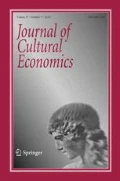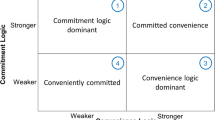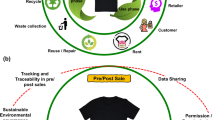Abstract
This paper proposes a production function for artistic output in which quantity and quality of output are specified as joint products from the inputs of labour and capital provided by individual artists. A model is constructed specifying the quantity of creative and commercial output and the quality of creative output as a function of inputs of labour time and of physical and human capital. Included in the latter is a variable to account for the contribution of creative talent to an artist's human capital. The model is estimated for a sample of practising professional visual artists and craftspeople in Australia. The results suggest that a model along the lines indicated may be taken as a plausible representation of the artistic production process.
Similar content being viewed by others
References
Abbing, H. (2002) Why Are Artists Poor? The Exceptional Economyof the Arts, Amsterdam University Press, Amsterdam.
Albert, R.S. (1994) “The Contribution of Early Family History tothe Achievement of Eminence ”, in Nicholas Colangelo and Susan Assouline (eds.), Talent Development, Ohio Psychology Press, Dayton, pp. 311–360.
Bishop, P. and Brand, S. (2003) “The Efficiency of Museums: a Stochastic Frontier Production Function Approach ”, Applied Economics 35(17): 1853–1858.
Bryant, W.D.A. and Throsby, D. (2006) “Creativity, the Economy andthe Behaviour of Artists ”, in Victor Ginsburgh and David Throsby (eds.), Handbook of the Economics of Art and Culture, North-Holland, Amsterdamforthcoming.
Caserta, M. and Cuccio, T. (2001) “The Supply of Arts Labour: Towards a Dynamic Approach ”, Journal of Cultural Economics 25 (3):185–201.
Cowen, T. and Tabarrok, A. (2000) “An Economic Theory ofAvant-garde and Popular Art, or High and Low Culture ”, Southern EconomicJournal 35 (2): 232–252.
Etlin, R.A. (1996), In Defense of Humanism: Value in theArts and Letters, Cambridge University Press, New York.
Gapinski, J.H. (1980) “The Production of Culture ”, Reviewof Economics and Statistics 62 (4): 578–586.
Gapinski, J.H. (1984) “The Economics of Performing Shakespeare ”, American Economic Review 74 (3): 458–466.
Rengers, M. and Madden, C. (2000) “Living Art: ArtistsBetween Making Art and Making a Living ”, Australian Bulletin of Labour,26 (4): 325–354.
Robinson, M.D. and Montgomery, S.S. (2000) “The TimeAllocation and Earnings of Artists ”, Industrial Relations, 39 (3):525–534.
Runco, M.A. (1999) “A Longitudinal Study of Exceptional Giftednessand Creativity ”, Creativity Research Journal, 12 (2): 161–164.
Taalas, M. (2003) “Costs of Production ”, in Ruth Towse (ed.). A Handbook of Cultural Economics, Edward Elgar, Cheltenham, pp. 152–160.
Throsby, D. (1977) “Production and Cost Relationships in the Supplyof Performing Arts Services ”, in K. A. Tucker (ed.), The Economics of theAustralian Service Sector, Croom-Helm, London, pp. 414–432.
Throsby, D. (1994) “A Work Preference Model ofArtist Behaviour” in Alan Peacock and Ilde Rizzo (eds.), CulturalEconomics and Cultural Policies, Kluwer Academic Publishers, Dordrecht, pp. 69–80.
Throsby, D. (1996) “Disaggregated EarningsFunctions for Artists” in Victor Ginsburgh and Pierre-Michel Menger (eds.), Economics of the Arts: Selected Essays, North-Holland, Amsterdam, pp.331–346.
Throsby, D. and Hollister, V. (2003) Don't Give Up Your Day Job: An Economic Study of Australian ProfessionalArtists, Australia Council, Sydney.
Throsby, D. and Withers, G.A. (1979) TheEconomics of the Performing Arts, Edward Arnold, London.
Wassall, G. and Alper, N. (1992) “Towards a Unified Theory of the Determinants of Artists' Earnings ”, in Ruth Towse and Abdul Khakee (eds.), Cultural Economics, Springer-Verlag, Heidelberg, pp. 247–260.
Author information
Authors and Affiliations
Corresponding author
Rights and permissions
About this article
Cite this article
Throsby, D. An Artistic Production Function: Theory and an Application to Australian Visual Artists. J Cult Econ 30, 1–14 (2006). https://doi.org/10.1007/s10824-005-9001-4
Received:
Accepted:
Published:
Issue Date:
DOI: https://doi.org/10.1007/s10824-005-9001-4




